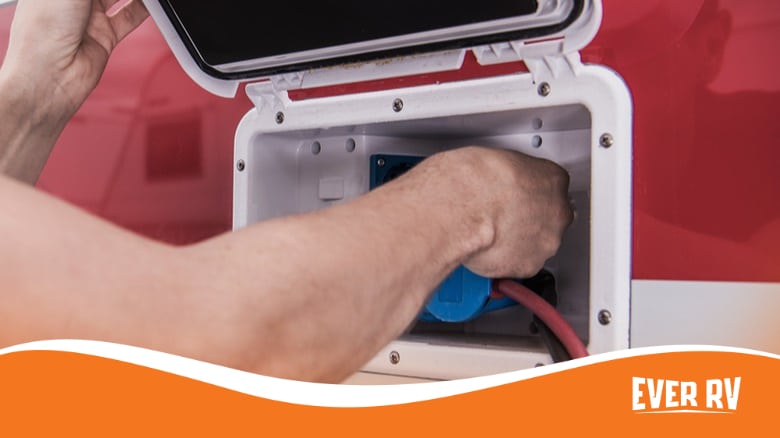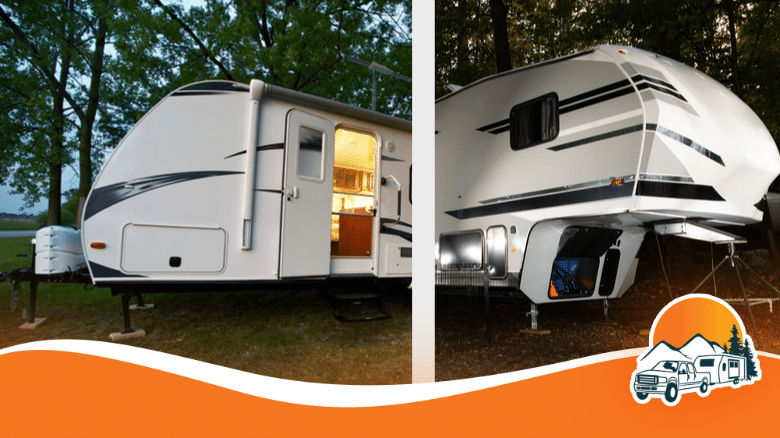What can you run on 50 amps in an RV? You can run various appliances like an air conditioner, refrigerator, and small kitchen appliances, as long as their combined power usage stays within the 50-amp limit.
Deciding when to add a generator to your RV setup is a crucial part of understanding your RV’s power capabilities. It’s not just about convenience—it’s integral to maintaining safety during your travels.

Knowing what appliances and devices you can operate simultaneously without overloading your system or causing damage is crucial. But let’s face it; this stuff can be complex!
No worries, though! With some basic knowledge of electrical systems and how to calculate power usage, you’ll soon master what you can run on 50 amps in an RV.
Plus, understanding how additional power sources, such as solar panels or gas generators, can supplement your RV’s power needs will give you even more flexibility. And we’re here to guide you through it all.
Understand What You Can Run on 50 Amps in an RV
The world of recreational vehicles (RV) and camping is fascinating, especially when it comes to understanding the power dynamics. Knowing what you can run on a 50-amp service in your RV not only enhances your comfort but also ensures safety.
A comprehensive grasp of how the electrical system works within smaller RVs or larger ones alike can help maximize their usage without risking overload.
The Basics of a 50-Amp Service
In essence, most modern-day campers equipped with a single 50-amp plug have two separate lines, each carrying around ~6000 Watts (~120 Volts). This dual-line setup effectively doubles up available wattage for use – potentially providing as much as ~12kW combined.
This capacity far exceeds that provided by standard household plugs, which typically offer just over one-tenth this amount at best. Upgrading from such lower-amperage extension cords could, therefore, significantly enhance overall capabilities within any mobile home-away-from-home setting.
Possible Appliances on A Single Line
If we look at operating appliances off just one line (~6kW), here are some possibilities:
- An average rooftop AC unit might consume between roughly ~1500 -~2000 W while running continuously.
- Your laptop charger may draw somewhere between approximately ~20-90 W depending upon make/model, etcetera.
- A typical microwave oven usually uses about ~1000 watts
- Standard coffee makers often require anywhere from around 800-1400 watts.
This list isn’t exhaustive but provides insight into the potential consumption rates these common items present. Remember, though, starting certain equipment like air conditioners often requires additional “surge” power, too, so always factor this into calculations.
Distribution Across Two Lines
To avoid tripping circuit breakers or causing damage due to overheating wires, etc., distributing the load evenly across both legs helps prevent scenarios where demand outstrips supply. Carefully planning which devices go onto each leg not only optimizes performance but also prolongs lifespan, thus ensuring optimal bang-for-buck ratio.
Understanding the electricity demands of different gadgets place allows us to plan more effectively, never exceeding safe limits, thereby avoiding potential issues down the road while enjoying all the comforts contemporary living offers right there on the open road.
Remember: Always consult professionals if unsure, especially when dealing with anything related to electrics, because safety is paramount above everything else.
Key Takeaway: Understanding the electrical dynamics of recreational vehicles (RVs) enables you to optimize the use of a 50-amp service without risking system overload, enhancing both comfort and safety. Modern RVs, equipped with a dual-line 50-amp plug, provide up to 12kW of power, which surpasses standard household plugs, allowing for the operation of various appliances such as air conditioners, laptops, microwaves, and coffee makers; proper distribution of the electrical load across these lines is key to preventing circuit issues and prolonging appliance lifespan.
Calculate Your Power Usage
In the world of RV travel, understanding your power usage is critical. Just like in a home or office building, an RV electrical system has limits on how much it can handle at once. In this case, we’re talking about 50 amps.
To keep everything running smoothly and avoid overloading your system with too many appliances drawing power simultaneously from the single 50-amp plug, here are some steps to calculate your total amperage needs:
Determine Each Appliance’s Wattage
The first step involves identifying each appliance’s wattage within your recreational vehicle – be it a smaller RV or a larger one. This information typically appears either directly on the device itself or within its user manual.
If not readily available there, a quick online search using specific model numbers should yield accurate results.
Understanding Starting Watts vs Running Watts
Bear in mind that certain devices have both starting watts (the initial surge required when turning them on) and running watts (the consistent energy needed during regular operation). For instance, AC units often require more juice initially than they do while maintaining their cooling cycle.
Convert Watts into Amps
To convert these figures into something useful for our purpose – namely amperes (amps) – divide by voltage which usually stands around standard 120V AC power.
Create A Power Consumption Chart
A handy way to visualize all this data would be creating a chart listing every electronic item along respective ampere values based upon operating hours per day.
Here are a few examples:
- A microwave oven: Typically uses between 13-15 amps
- An air conditioner unit: Can draw anywhere from 12-16 amps depending upon conditions but may spike up momentarily startup.
- A refrigerator: On average, consumes 5-8 amps varying according to settings/model, etc.
- Lights & Electronics such as LED lights, laptops charging, and televisions vary greatly, consuming less than one amp up to eight, respectively.
Remember, actual consumption might differ slightly, so always leave room for error to ensure nothing gets overloaded, potentially damaging expensive equipment.
Safeguard Against Simultaneous Use Of High-Amp Devices
While possible, run several high-amperage items individually. Running high amp devices at the same time could spell trouble and lead to potential damage due to overload.
Incorporating simple practices like switching off unnecessary lighting and unplugging unused electronics whenever possible reduces overall demand significantly, thereby helping manage consumption effectively and ensuring smooth sailing through camping adventures.
Key Takeaway: Mastering your RV’s power usage is essential, especially for a system limited to 50 amps, and involves a series of steps, including determining each appliance’s wattage, understanding the difference between starting and running watts, converting watts to amps, and creating a power consumption chart. The importance of managing power draw is emphasized, with strategies such as individually running high-amperage devices and reducing unnecessary power usage to prevent overloading the system and thereby securing an effective and damage-free camping adventure.
Choose the Right Appliances
Selecting appliances that are optimized for a 50-amp RV electrical system can feel like navigating through an electric maze. But with careful consideration and understanding of power consumption, you can equip your recreational vehicle with all the home comforts without overloading your system.
Gauging Power Consumption
The first step in this electrifying journey is to understand how much power each appliance consumes. For instance, AC units usually draw between 12-16 amps, while refrigerators consume about 6-8 amps when running but only around 1-2 amps otherwise. Devices such as microwaves or coffee makers might require up to a whopping 13 amps each.
Bear in mind standby power consumption, too – some devices continue drawing small amounts even when not actively used. You’ll find these details within product specifications or by using online resources similar to Energy Use Calculator.
Picking Energy-Efficient Appliances
To make optimal use of your available shore power supply, consider energy-efficient models whenever possible. These types often utilize less electricity than their standard counterparts, which means more room for other devices within your allotted amperage on the RV electrical supplies list.
- An LED light bulb instead of traditional incandescent ones – LEDs use significantly less energy and last longer too.
- A convection microwave rather than an oven could save several amp-hours per day without sacrificing functionality.
Prioritizing Essential Appliances
In deciding what appliances should be powered by a single small AC unit on your RV’s electrical service, it’s crucial to prioritize based on necessity and frequency of usage: essential items like refrigerator or water heater will need constant access, whereas others may only be needed occasionally such as hair dryers or vacuum cleaners.
- Air Conditioning: This becomes indispensable during hot summer months, especially if traveling through warmer climates; however, remember these are one of the highest consumers, so plan accordingly.
- Fridge/Freezer: Continual operation is required, yet modern RV fridges manage well under a heavy-duty 50-Amp extension cord.
- Cooking Devices: Microwaves & induction cooktops provide cooking convenience yet take a considerable amount from the total allotment; hence choose wisely considering meal prep routines.
Key Takeaway: Navigating the selection of appliances suitable for a 50-amp RV electrical system requires understanding each device’s power consumption and opting for energy-efficient models wherever possible. It is crucial to weigh the necessity and frequency of appliance usage, favoring essential, frequently used items such as air conditioners, refrigerators, and primary cooking devices, and remember to account for standby power consumption in your power management plan.
Install Proper Wiring
When it comes to running a 50-amp service in your RV, the importance of installing proper wiring can’t be overstated. It’s not just about ensuring smooth operation for all your appliances; it’s also about safeguarding against potential electrical hazards.
The Significance of Correct Wiring
You might ask yourself, “Why is correct wiring so important?” Well, when you have properly wired systems within your RV, electricity flows seamlessly from its sources – such as an RV power cord post or shore power – to each and every one of your devices and appliances. This reduces any risk associated with overloading circuits, which could lead to fires or damage to equipment.
In addition, having correct wiring means that you’re able to take full advantage of a 50-amp service in an RV. With this kind of capacity at hand – imagine being able to run multiple high-power-consuming appliances simultaneously without worrying about unexpected blackouts or damaging sensitive electronics due to voltage fluctuations.
A Closer Look At Your RV Electrical System
Installing proper wiring effectively requires understanding how the RV electrical system works. A typical modern-day recreational vehicle has two types: a low-voltage DC system powering things like water pumps and lights, while a higher-voltage AC handles items like air conditioners and microwaves. The key here lies in making sure these are installed correctly to handle their respective loads efficiently under conditions where using a single 50-amp plug becomes a necessity rather than a luxury choice. Remember, improper installation can result in serious issues, including appliance failure and even fire hazard situations for the camper van itself…
Tips For Safe Installation
- If DIY isn’t really up your alley, then consider hiring professional help-certified electricians who specialize in working with smaller RV models and larger ones alike. They’ll ensure everything gets done right the first time around, keeping you safe and sound during your travels ahead.
- Different regions may have different codes concerning installations, so make sure that whatever work gets done complies fully with local regulations to avoid endangering anyone inside during travel times.
- Maintain regular checks on connections, as wear and tear can cause loose fittings leading to potentially dangerous situations down the line if left unchecked for a long period of time. Note: This is especially true if heavy-duty extension cords are used frequently to connect to park outlets or a home base.
Key Takeaway: Installing proper wiring in your RV is essential not only for the smooth functioning of appliances but also for mitigating potential electrical hazards. A well-wired RV system ensures seamless electricity flow, mitigates the risk of overloading circuits, and optimizes the benefits of a 50-amp service, enabling simultaneous use of high-power appliances without concerns of blackouts or voltage fluctuations. The setup entails understanding the intricacies of the RV electrical system, incorporating both low-voltage DC and higher-voltage AC circuits for various appliances. Safe installation, possibly aided by certified electricians and compliant with regional regulations, along with regular checks for wear and tear, are fundamental to maintaining an efficient and hazard-free electrical system in your RV.
Monitor Your Power Usage
It’s not just about preventing an overload of the electrical system – although that’s important too.
In essence, keeping track of how much electricity each appliance uses allows you to manage their operation effectively without exceeding the limit provided by a single 50-amp plug.
The Importance of Monitoring Power Usage
Do you ponder why this is significant? Well, let me tell you: An overloaded circuit can lead to serious problems like fires or permanent damage. And nobody wants that.
- Maintaining regular checks on your RV’s electrical systems aids in tracking overall performance levels besides detecting potential malfunctions promptly.
- If necessary, prioritize using high-energy-consuming appliances during times when other less critical items aren’t needed as much, such as AC units during peak heat hours, then switch them off later while using smaller gadgets like laptops or cell phone chargers. This strategy allows efficient use of available amperage without straining circuits excessively at once.
Conclusion
Exploring the intricacies of your recreational vehicle’s electrical system is a mission but one that can be immensely rewarding.
Understanding what you can run on 50 amps in an RV empowers you to maximize your power usage and truly make the most of life on the road.
Figuring out how much juice your gadgets require is essential for ensuring you get the most out of 50 amp RV power. It’s all about balance!
Safety should always be at the forefront – ensuring proper wiring for a 50 amp service is non-negotiable.
Finally, keeping tabs on your power usage will help avoid overloads and keep everything running smoothly. Power management? Nailed it!







